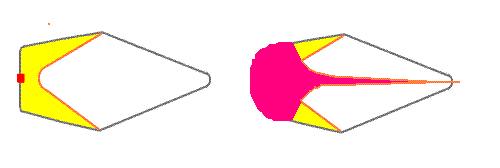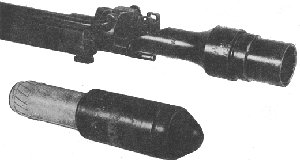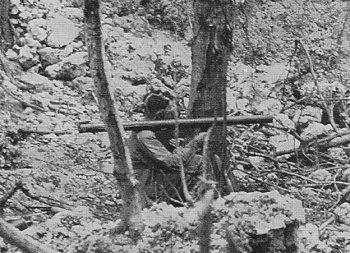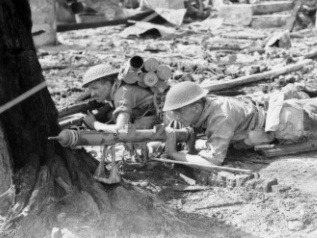![]() The Pacific War Online Encyclopedia
The Pacific War Online Encyclopedia
|
| Previous: Shaoyang | Table of Contents | Next: Shari |

Shaped charge before and after detonation, showing formation of jet
Shaped charges (also sometimes called hollow charges) are explosive
charges shaped into a hollow cone or
bowl, lined with metal, and detonated from the base. As the detonation
wave propagates around the bowl, a jet of explosive residues and metal
forms that shoots forward at extremely high velocity (several thousand
meters per second.) The high-velocity jet is capable of punching
through thick armor and showering
whatever is on the other side with white-hot metal fragments. A shaped
charge is most effective when the charge goes off some distance from
the surface of the armor, so there is room for the jet to form
and accelerate.
Tactical use of shaped charges against tanks requires that there be some way to detonate the charge at the appropriate standoff distance. The earliest shaped charge weapon was the British Number 69 rifle grenade, which went into production in May 1940 and was duplicated by the Americans. The Germans subsequently developed antitank grenades that an infantryman could attached to the tank with large magnets, if he could get close enough, but this technology was not duplicated by any of the Allies. The Americans turned instead to rocket launchers (bazookas) as a delivery system for shaped charges, while the British developed a spigot discharger (the PIAT). The Germans copied the American system, with improvements, as the Panzerschreck. They also developed a light disposable one-shot launcher, the Panzerfaust.

Japanese shaped charge rifle grenade. U.S. Army. Via ibiblio.org
The Japanese made use of explosives attached using magnets, like the German antitank grenades, but these were simple disks rather than shaped charges and were effective only against light deck and rear armor. The Japanese also produced both rifle (Type 2) and hand-thrown (Type 3) shaped charge grenades, the latter with a hemp tail to give it some chance of hitting the target head-first.
HEAT (high explosive antitank) rounds were shaped charge rounds fired by antitank guns or conventional artillery. These proved only moderately effective, because the spin imparted to the round by conventional rifled barrels tended to weaken the penetrating jet. However, the round was equally lethal at any range, since it did not depend on its own kinetic energy to penetrate the target. The Japanese produced a HEAT round for their artillery known as the "anti-tank perforating shell" (Tai-sensha-senkō-dan or Ta-dan).
Shaped charges could be used against bunkers as well as tanks. The Americans made extensive use of the bazooka as a bunker buster as it became available in the Pacific.
The Japanese experimented with a shaped charge warhead, the "V" warhead, for the Type 91 torpedo. Tests demonstrated that this could punch completely through the underwater protection of a Colorado-class battleship. However, only three saw use in combat.

U.S. Marine Corps. Via Morison
(1958)
The M1 2.36" (60mm) rocket launcher was better known as the bazooka, after a bizarre musical instrument invented by musical comedian Bobby Burns. The launcher was a long tube open at both ends with a handle and sights. The rocket was loaded into the rear of the tube and its electrical igniter wired to electrodes at the rear of the tube. When the trigger was pulled, a battery powered the igniter and launched the rocket out the front of the tube. Later versions were lighter, could be broken into two pieces for easier transport, and used an impulse magneto in place of the battery.
The bazooka could penetrate about 80mm (3.1 inches) of armor and had a range of about 400 yards (370 meters). However, effective use required a loader to assist the firer, and the back blast of the rocket was both a hazard to anyone behind the bazooka and a source of dust and smoke that gave away the firer's position. The weapon did not reach the Pacific in any numbers until late 1943.
In addition to shaped charges, the bazooka could fire a white
phosphorus bomb for screening and
antipersonnel use.

Australian War Memorial. Via Wikimedia Commons.
Cropped by author.
The PIAT was a peculiar and clumsy weapon that could nonetheless be quite effective. It consisted of a tube containing a steel rod or spigot and an enormous spring. The end of the tube opened into a tray into which the projectile was loaded. When the weapon was fired, the spring drove the spigot into the tail of the projectile, itself a hollow tube, where it set off a propellant charge and shot the projectile off the end of the spigot. At the same time, the recoil recocked the weapon for the next shot. The projectile had a theoretical range of 750 yards (690 meters) but the weapon was hopelessly inaccurate beyond about 100 yards (90 meters). The shaped charge could penetrate about 75mm (3 inches) of armor.
The PIAT had little back blast, but it was heavy and took strenuous effort to cock by hand for the first shot. It was nonetheless effective in resolute hands. Production began in late 1942.
References
Branfill-Cook (2014)
Gilbert
(2001)
The Pacific War Online Encyclopedia © 2007, 2009, 2011, 2015 by Kent G. Budge. Index